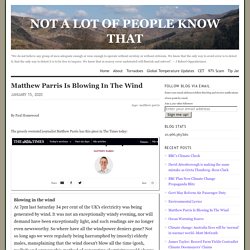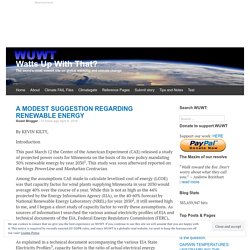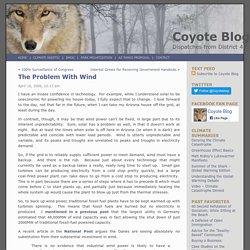

Google Deepmind AI Project to Improve Renewable Energy Reliability Quietly Disappeared – Watts Up With That? Guest essay by Eric Worrall A Google project to use artificial intelligence to improve the predictability of wind energy appears to have failed.

Engineers who worked on the project have reportedly removed mention of their work from their linked in profiles. Climate change falls down the agenda at A.I. lab DeepMind after energy heads leavePUBLISHED THU, DEC 17 2020 3:55 AM ESTSam Shead@SAM_L_SHEADKEY POINTSThe DeepMind Energy unit, which has attracted its fair share of attention over the years, has vanished and none of the company’s staff mention it on their LinkedIn profiles. This is not the first time a high profile Google renewable energy project failed. Back in 2016 Google Engineers announced the failure of an engineering project to find a feasible path to 100% renewable energy. 5 13 votes Article Rating.
UK: Wind Power Capacity, Reliability and Grid Stability. US: Wind Power Capacity, Reliability and Grid Stability. Australia: Wind Power Capacity, Reliability and Grid Stability. Europe: Wind Power Capacity, Reliability and Grid Stability. New Website For Wind Farm Data. By Paul Homewood Someone tipped me off about this website, which has a lot of useful data about renewable energy, both in the UK and Europe: It is worthwhile playing around with it, but one useful feature is a table of output, capacity factors etc for each offshore installation in the UK.

Currently the rolling 12-month average capacity loading is 40.6%. What I found particularly useful i8s this chart: It shows the time distribution of capacity loads, both for individual wind farms and overall. So for instance, the load factor was 36.3% or more for 50% of the time, ie the median. The curve for all windfarms is for the last five years. Matthew Paris Is Blowing In The Wind. By Paul Homewood The grossly overrated journalist Matthew Parris has this piece in The Times today:

Blown away by wind farm "capacity" versus actual output. Promises, promises.

We’re constantly being blown away with the growing capacity of wind farms to provide renewable energy, but they’ve yet to produce anywhere near their projected capacity. Compounding their lack of production, is the intermittency of what they produce. Let’s be clear about what that means. First, it’s not renewable energy, it’s only renewable electricity, more accurately its only intermittent electricity. Renewables have been the primary driver for residents of Germany, Australia, and California behind the high costs of electricity. In Australia, they’re losing businesses, jobs, and money – the new definition of madness that’s becoming laughable stuff. The top-billed reason Green/Labor was supposed to fare so well at the polls, was Australians are, apparently, spending their every waking hour fretting about carbon dioxide gas and believing windmills and solar panels will save the day.
Bear with me as we look at some energy numbers. A MODEST SUGGESTION REGARDING RENEWABLE ENERGY. By KEVIN KILTY, Introduction This past March 12 the Center of the American Experiment (CAE) released a study of projected power costs for Minnesota on the basis of its new policy mandating 50% renewable energy by year 20301.

This study was soon afterward reported on the blogs PowerLine and Manhattan Contrarian. Among the assumptions CAE made to calculate levelized cost of energy (LCOE) was that capacity factor for wind plants supplying Minnesota in year 2030 would average 40% over the course of a year. While this is not as high as the 44% projected by the Energy Information Agency (EIA), or the 40-60% forecast by National Renewable Energy Laboratory (NREL) for year 20302, it still seemed high to me, and I began a short study of capacity factor to verify these assumptions. 1. Thus, capacity factor seems a very straight forward concept.
Seasonal generating capacity is defined in many places, and always in the following way. Table 1. 2. End notes: Like this: Like Loading... U.S. Are Studies of High Penetrations of Wind Power Valid? By Richard D.

Patton When examining penetrations of wind power, there seem to be two types of papers. In one type, wind penetration up to 20% is difficult but doable, and in the other type wind penetrations of 50-60% are quite easy. In fact, renewable penetrations of up to 90%-100% are claimed. As an example of the first type, consider the Western Wind and Solar Integration Study performed by GE under contract to NREL (National Renewable Energy Lab). “There appears to be minimal stress on system operations at up to 20% wind penetration. The GE/NREL paper invites skepticism because they freely admit that their reserves are stretched and that interconnections provide extra reserves.
Electric Power from Renewable Energy: Realities for Policy-Makers. Abstract.

Beware Windpower's "Homes Served" Claims - Master Resource. The Problem With Wind. I have an innate confidence in technology.

For example, while I understand solar to be uneconomic for powering my house today, I fully expect that to change. I look forward to the day, not that far in the future, when I can take my Arizona house off the grid, at least during the day. In contrast, though, it may be that wind power can't be fixed, in large part due to its inherent unpredictability. Sure, solar has a problem as well, in that it doesn't work at night. But at least the times when solar is off here in Arizona (ie when it is dark) are predictable and coincide with lower load periods.
So, if the grid is to reliably supply sufficient power to meet demand, wind must have a backup. So, to back up wind power, traditional fossil fuel plants have to be kept warmed up with turbines spinning. A recent article in the National Post argues the Danes are seeing absolutely no substitution from their substantial investment in wind.